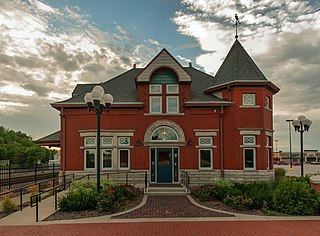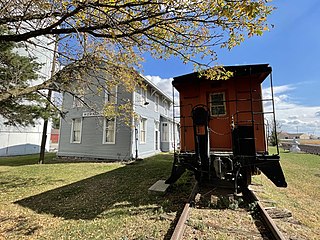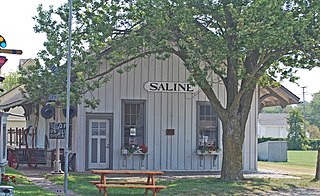
The Chicago, Milwaukee, St. Paul and Pacific Railroad Depot and Lunchroom are two buildings located in Wells, Minnesota, and built by the Chicago, Milwaukee, St. Paul and Pacific Railroad in 1903.

The Chicago and Northwestern Depot is a former railway station in Wilmette, Illinois, which has been on the National Register of Historic Places since 1975. The station served the Chicago and North Western Railway along what is now Metra's Union Pacific/North Line. It was built in 1873 as a passenger station and became a freight station in the 1890s before closing in 1946. The station was relocated to its current location on June 13, 1974, and it has since been remodeled as a restaurant. The depot has been called "Wilmette's most historic building," and the Chicago Sunday Times referred to the station as "the finest station on the entire line" upon its opening.

The Chicago, Milwaukee and Pacific Railroad-Albert City Station, also known as the Albert City Depot, was built by the Chicago, Milwaukee, St. Paul and Pacific Railroad in 1899 to serve the farms around Albert City, Iowa. The railroad built the line from Des Moines to Spencer, Iowa, in 1899 to serve local agriculture. Albert City was platted the same year. The depot was built for passenger service as well as freight.

The Chicago and Northwestern Railroad Depot is a railroad station located between Suffolk and Lowell Streets in Ironwood, Michigan. It was listed on the National Register of Historic Places in 1985.

Chicago, Rock Island and Pacific Railroad-Wilton Depot is an historic building located in Wilton, Iowa, United States. The Mississippi and Missouri Railroad built the first rail line in 1855 in what would be called Wilton Junction. The railroad became the Chicago, Rock Island and Pacific Railroad (CRI&P) a few years later. A wooden frame depot and a separate freight facility served the community. The railroad placed their repair and maintenance center in Wilton, and it remained here until 1881 when they started to move operations to Davenport and Muscatine. Rail service continued to increase along the CRI&P, which necessitated a new depot in Wilton. This single-story, brick Romanesque Revival structure was completed in 1898. Six passenger trains stopped in Wilton in 1911, and by 1922 same-day service to and from Chicago began.
The Chicago and North Western Passenger Depot is a historic building located in Wall Lake, Iowa, United States. Wall Lake was served by both the Chicago & North Western Railroad and the Illinois Central Railroad, which gave it a significant rail presence from the 1880s until World War II. The C&NW depot is an example of a combination station plan. The plan combined both passenger and freight services in one building. They were commonly used during the heyday of railroad growth round the turn of the 20th century. However, the old Wall Lake C&NW depot was moved and used for freight. What would have been the freight room was used here for a lunchroom. C&NW had three standard combination depot plans that have been attributed to the prominent Chicago architectural firm of Frost & Granger. The Wall Lake depot was the largest of the three as it incorporated a women's waiting room, but it was actually 9 feet (2.7 m) shorter than the general plan because freight was processed in another facility. The depot was built in 1899 by A.H. Carter & Co. of Cedar Rapids, Iowa as a replacement depot. The single-story frame structure is the only building used as a depot that remains in town. It was listed on the National Register of Historic Places in 2003.

The Greenback Depot is a former railroad station located in Greenback, Tennessee, United States. Built in 1914 by the Louisville and Nashville Railroad (L&N), the depot served rail freight and passengers traveling in and out of the Greenback area until 1954. Restored for use as a community events center by Ronald Edmondson in the early 2010s, the depot was listed on the National Register of Historic Places in 2013 in recognition of its role in the area's transportation history.

Bennington station is a historic former railroad depot at 150 Depot Street in downtown Bennington, Vermont. Built in 1897-98 by the Bennington and Rutland Railroad, it is the only Richardsonian Romanesque railroad station in the state of Vermont. It was listed on the National Register of Historic Places in 1988 as Bennington Railroad Station, and since then housed a restaurant, which closed in 2018. It now is an office space for MSK Engineering and Design and Goldstone Architecture.

Missouri, Iowa & Nebraska Railway Co. Depot-Weldon, also known as Weldon Depot, is a historic structure located in Weldon, Iowa, United States. The Missouri, Iowa, and Nebraska Railway Company (MI&N) was established in 1870 with the merger of the Alexandria and Nebraska City Railroad Company and the Iowa Southern Railway under the direction of Francis M. Drake. The MI&N decided to extend the line from Corydon, Iowa to Van Wert. J.P. Kline sold the railroad 70 acres (28 ha) of farmland on which the town of Weldon was founded. The railroad began construction of the Weldon Depot in 1880, the same year the town was laid out. The depot was completed the following year. The MI&N was reorganized in 1886 as the Keokuk & Western Railroad. They operated the rail line through Weldon until 1901 when it became part of the Chicago, Burlington & Quincy Railroad. Passenger service continued in Weldon until December 1945. The last freight train went through the station in January 1946. The tracks were torn out when the railroad ceased service on the line. The depot was given to the town of Weldon, which maintains it. It was added to the National Register of Historic Places in 1991.

Illinois Central Passenger Depot-Storm Lake, also known as the Storm Lake Depot, was an historic building located in Storm Lake, Iowa, United States. The Iowa Falls & Sioux City Railroad, an Illinois Central Railroad (IC) subsidiary, built the first tracks through town in 1870. They also built a two-story frame combination freight and passenger depot the same year. The present depot is a second generation IC structure built of brick. The building's architectural style is Prairie School with Tudor Revival elements in the dormer and canopy ends. It was designed by IC architect E.E. Bihl, and it is similar to the railroad's depots in Flossmoor, Illinois and Fort Dodge, Iowa. The new passenger depot was completed in August, 1915, and the old depot was re-purposed for a dedicated freight depot. It was torn down sometime before 1948. Passenger service remained high during the 1910s and 1920s, with the decline accelerating after World War II, and it ended all together in the late 1960s. While freight trains continue to use the IC's tracks, the depot has been abandoned. It was listed on the National Register of Historic Places in 1990. The Storm Lake Illinois Central depot was demolished on February 25, 2013.

The Chicago & Northwestern Passenger Depot and Baggage Room-Carroll, also known as the Carroll Depot is a historic building located in Carroll, Iowa, United States. It is an example of a replacement station built along its Iowa mainline by the Chicago and North Western Railway (CNW) in 1896. It replaced a two-story, frame, combination station that was first built in 1867 by its predecessor line, the Cedar Rapids and Missouri River Railroad. That building had experienced two fires. The CNW had built two branch lines from Carroll in 1877 and 1880, which increased business and necessitated a larger depot. The Carroll Express Building was also built across the street for further railroad use. A separate wooden freight house had been built in 1888. Chicago architect Charles Sumner Frost designed this station in the Romanesque Revival style. The baggage room is separated from the depot by a breezeway. Frost designed at least 15 stations for the CNW in Iowa and Nebraska and another 14 in the Chicago area. The building represents the prosperity of the line during the Golden Age of Railroads.

The Chicago and North Western Office Building/Passenger Depot-Lake City, also known as the Lake City Depot, is a historic building located in Lake City, Iowa, United States. The Toledo & North Western Railroad (TNW) laid the first tracks through town in 1881–1882. Because Lake City was already established, they built a two-story, frame, combination depot and the southeast edge of town. Because of its convenient location, the TNW also built their repair and maintenance shops in Lake City in the 1880s. They placed their division headquarters here in 1887. The Chicago and North Western Railway (CNW) acquired controlling interest in the TNW in June 1881, and ran it separately until it formally acquired it in 1890.

The Rock Island Passenger Depot is an historic building located in Oskaloosa, Iowa, United States. The Chicago, Rock Island & Pacific Railroad arrived in town in 1876, and they built a frame combination depot on the north side of the tracks. This depot replaced the original one in 1888 on the south side of the tracks, and it served ten passenger trains a day. A separate freight depot was built to the east. President Theodore Roosevelt stopped here when he came to dedicate the new Y.M.C.A. in 1903. The freight and passenger depots were combined into a single facility once again in 1930, utilizing the passenger depot. The depot was officially abandoned in 1973. It was listed on the National Register of Historic Places in 1989. The building now houses a pub.

The Chicago, Milwaukee & St. Paul Narrow Gauge Depot-LaMotte is a historic building formerly located in La Motte, Iowa, United States. The Chicago, Bellevue, Cascade & Western Railroad was incorporated in August 1877, to build a narrow-gauge railway from Bellevue to Cascade. Narrow-gauge was chosen because it was cheaper to build, and it could negotiate the tight turns on the rugged terrain better. Construction began the following year, but lack of money doomed the project. The Chicago, Clinton, Dubuque and Minnesota Railroad took over the project, and it was completed on December 30, 1879. The first train reached Cascade on January 1, 1880. Ten months later they sold all their holdings to the Chicago, Milwaukee & St. Paul Railroad, and this line became a branch line of the Milwaukee Road. That same year a frame depot was built in La Motte. It served as a combination freight and passenger station until it was destroyed by fire in 1910. This depot replaced it the following year. The 1½-story frame combination station represents the corporate style and standardized practices of the Milwaukee Road. However, it reflects the depots they built in the late 19th century, so it was somewhat outdated when it was built.

The Chicago, Rock Island and Pacific Passenger Depot-Pella, also known as the Pella Depot and the Rolscreen Museum, is a historic building located in Pella, Iowa, United States. The Des Moines Valley Railroad built the first tracks through the area in 1865, and they built a simple frame depot to serve passenger's needs. For 10 years, Pella served as the only rail stop in Marion County until a competing station was built in Knoxville, Iowa by the Chicago, Burlington, and Quincy Railroad. The Chicago, Rock Island & Pacific Railroad leased the Des Moines Valley's tracks beginning in 1878 and provided freight service through 1980. The old frame building was replaced, in 1906, with a single story, brick depot–a conventional building style for the railroad. The new, brick depot served as a passenger station until the latter 1940s. The last passenger service was as a stop on a short line motor train service between Eldon in southeast Iowa and Des Moines. The station was freight only by 1949.

The Chicago, Milwaukee, St. Paul & Pacific Combination Depot-Hornick, also known as the Hornick Depot, is a historic building located in Hornick, Iowa, United States. The town was patted by the Chicago, Milwaukee, St. Paul & Pacific Railroad's land company when the railroad created a branch line from Manilla, Iowa to Sioux City. Completed in 1887, the railroad built this two-story frame structure to serve as its passenger and freight depot. It is one of six such depots that remain in Iowa, and the best preserved. These buildings were built from a standard design used by the railroad. The two-story stations included living quarters for the station manager because the towns had yet to develop when the depot was built. This was an island depot, with freight loaded on the north side and passengers boarded on the south. Decorative elements on this depot include lathe-turned wooden finials, angled wooden brackets, and bracketed door and window hoods. Passenger service ended in the 1950s, and grain was loaded here until 1980 when the Milwaukee Road abandoned the Sioux City branch line. The building was listed on the National Register of Historic Places in 1990. It has been converted into a local history museum.

The Fremont, Elkhorn & Missouri Valley Railroad Passenger Depot, also known as the Chicago and North Western Railway Passenger Depot and presently as the Douglas Railroad Interpretive Center, was built in 1886 in Douglas, Wyoming to accommodate traffic on the Fremont, Elkhorn and Missouri Valley Railroad's (FE&MV) terminus at the newly built town. The depot was built as a fairly small, cautious investment in a possibly ephemeral frontier town. Immediately following the completion of the depot Douglas saw an epidemic of typhoid fever and the worst winter in a generation, and the railroad decided to push on to Casper for its terminus. The town's population declined from 1600 in 1886 to 900 in 1888. By 1891 Owen Wister reported that Douglas had a population of about 350. However, by 1910 Douglas had 2246 residents and hosted the Wyoming State Fair. The presence of the fair stimulated rail traffic, while the FE&MV merged with the Cheyenne and Northern Railway in 1903. In 1905 oil development started. In the 1950s coal mining began for the Dave Johnson Power Plant and the railway expanded its Douglas facilities to accommodate the traffic, closing the original depot and building a larger facility. The depot was acquired from the railroad's successor, the Chicago and North Western Railway, by the city in 1990.

The Milwaukee and St. Paul Railway Combination Depot is a historic building located in Decorah, Iowa, United States. After the Milwaukee and St. Paul Railroad, later the Chicago, Milwaukee, St. Paul and Pacific Railroad, choose a different route for their north–south mainline, community leaders convinced them to build a spur to Decorah. This would open the town to larger markets to ship the products produced there. The tracks were completed in 1869, and a boxcar served as the first depot. That same year this single-story, wood-frame structure with Greek Revival features was completed south of the central business district. It served as a combination depot, servicing both passengers and freight. After the arrival of the Chicago, Rock Island and Pacific Railroad in 1884 the Milwaukee Road started to plan a new passenger depot in Decorah. It was completed on the east end of the main commercial street in 1888. When it opened, this building continued to serve as a freight depot. Over the years its platforms were shortened, and sometime between the 1930s and the 1950s, the southwest end of the building was shortened. The Milwaukee Road abandoned the depot in 1971, and the tracks that flanked the building were removed the same year. The former depot itself was renovated for non-railroad use. This is believed to be a rare extant example of a wooden combination depot in Iowa. The building was listed on the National Register of Historic Places in 2016.

The Saline station, also known as the Detroit, Hillsdale and Indiana Railroad-Saline Depot, is a former railroad depot located at 402 North Ann Arbor Street in Saline, Michigan. It was listed on the National Register of Historic Places in 1994. The building now houses the Saline Depot Museum.

Kent is a former station for the Erie Railroad in Kent, Ohio, on the Erie main line between Chicago and Jersey City. Along the main line, the next station west towards Chicago’s Dearborn Station was Tallmadge, while east towards Jersey City’s Pavonia Terminal was Ravenna. The station was located 615.9 miles (991.2 km) from Pavonia Terminal and 382.6 miles (615.7 km) from Dearborn Station. The city of Kent was the headquarters of the Kent Division, with car shops and a large yard maintained just south of the station until 1930. About one mile (1.6 km) north of the station were the Erie Railroad's Breakneck Yards, which operated into the 1960s.






















